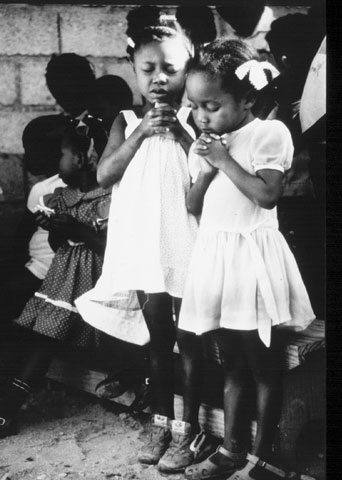
“Girls Praying During Church Service, Port-au-Prince, Haiti” (Mev Puleo)
 HOPE SINGS, SO BEAUTIFUL: GRACED ENCOUNTERS ACROSS THE COLOR LINE
HOPE SINGS, SO BEAUTIFUL: GRACED ENCOUNTERS ACROSS THE COLOR LINE
By Christopher Pramuk
Published by Liturgical Press, $19.95
Christopher Pramuk is a theologian with the writing style of a mystical novelist and the concerns of a social ethicist. He is devoted to promoting racial solidarity in an age of increasingly complex global systems, and his striking work captures the spiritual significance of racial consciousness for individuals and communities. His new book, Hope Sings, So Beautiful, includes a photo that connects my own conversion to solidarity with his.
For years, the photograph, “Girls Praying During Church Service, Port-au-Prince, Haiti,” was taped to my office door. In high school, I’d worked at a camp for adopted Haitian children and wanted to go to Haiti to learn, grow, and be in solidarity with its people. Pramuk and his wife traveled to Haiti as prospective adopted parents. They have created a family with four children, two adopted and two biological.
Pramuk posits racism as “the symptom of a profound poverty, a terrible captivity.” Through others’ theological and spiritual writings -- most notably of Frs. Bryan Massingale and Thomas Merton -- through the artistic works of Billie Holiday and Stevie Wonder, and the activist practices of Franciscan Sr. Thea Bowman, Martin Luther King Jr., and the Taos Indians, Pramuk cultivates a new vision for white and black Christians.
Among the greatest challenges Pramuk poses to his readers is a call to conversion through mutual risks and responsibilities. Whites and blacks must confront their own histories, suspicions and tensions at all levels -- and “cross geographic, economic, and racial boundaries in order to simply be present to one another’s experiences, to celebrate them and, indeed, sometimes to mourn them.”
Persons of privilege, regardless of color, must confront the structures and systems that perpetuate the -isms and inequality: “Whose sins are being paid for as we build more and bigger prisons, fill them with young black and Latino men, and staff them with working class whites who desperately need the jobs?”
Pramuk asks the hard questions and gives potential answers to the problem of racism within the Christian community through examples of reconciliation: mere presence, shared worship, art and practices of resistance and hospitality to a society fueled not by solidarity but by competition and attempts to fill spiritual voids with consumerism, sex, technology and violence.
Though racial difference and human dignity is the primary theme of Hope Sings, So Beautiful, Pramuk also takes up discrimination against homosexual persons and the tensions present between church hierarchy and lay faithful on a number of issues. These topics are welcome additions to his overall frameworks of solidarity and sacramentality. Though the book includes the voices of women, there could have been more emphasis on feminist contributions to racial reconciliation, as well as a greater call for wealthy Christians to examine the connections between race and inequality.
Pramuk’s purpose is nonetheless clear and compelling and will captivate the reader with his own graced encounter across the color line: “At issue here is not foremost the ‘individual rights’ of peoples of color, women, or gays in the church as an extension or microcosm of liberal democratic society. Rather it is the vocation to theological wholeness and integrity in the church that ought to be out ahead of the game, leavening a secular society by its visible embodiment of love, justice, and unity-in-difference.”
In 2012 and 2013, my dream came true. I co-led a group of students to Port-au-Prince for an immersion trip that took me to metal art communities, refugee tent camps, schools, churches, clinics and AIDS orphanages. Pramuk’s book has helped me reflect on my own graced encounter across the color line. Questioning middle-class stability, inequality among nation states, and segregation among our churches and neighborhoods is, indeed, a more risky way of life, but also a more hopeful way of life rooted in the reign of God.
[Arlene Montevecchio is a doctoral student of theology at Duquesne University in Pittsburgh. She writes from Erie, Pa., where she lives with her husband and two sons.]



